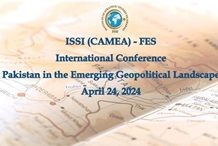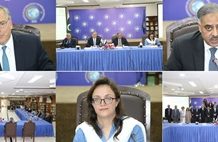A new mess up is being created. A tussle is renewed. Maritime disputes in South China Sea are taking a new shape, where allies and opponents are taking sides that would change the geo-politics in the region. A new geo-strategic configuration keeps evolving, challenging the old settlement. Many are cracking down the post-war status quo, believing that a number of maritime disputes were not resolved under the San Francisco peace treaty in 1951.
They want the United Nations to resolve them under the 1982 Law of Sea Convention. China, on the other hand, blocks all multi-lateral moves to change the status quo in the South China Sea. China has historical claims over these territories.
There are a number of maritime disputes between China and the Philippines, Vietnam, Indonesia, Malaysia, and Brunei. Notable of these Islands are the Paracel archipelago, 45 islands and numerous reefs and rocks of the Spratly archipelago, the Macclesfield Bank and the three islands of the Pratas group. Under the ‘US pivot to Asia’, these maritime differences have been revived in the name of ‘peaceful resolution’. Tension has rose high between China and Japan over the Diaoyu/Senkaku Island issue, after 2010.
China started construction work at the reclaimed reefs namely; Geven, Mabini (Johnson), Kagingen (Fiery Cross), Calderon (Caurteron) and Kennen (Chiguo). Adversaries perceive these developments as China’s maritime blue water navy modernisation in South China Sea.
Whilst the United States would focus on ‘peaceful resolution’ of the maritime disputes, China sees it differently. It thinks that any outsider is not a claimant to these disputes and it should not meddle. Hence they want to maintain the status quo, but still believe in developmental and non-military work.
The up-gradation of naval bases by the US especially in the Philippines, Vietnam, Singapore, and Indonesia are sources of concerns for China. It thinks that Japan has also been meddling on behest of the United States. To protect its interests, China finally erected an Air Defence Zone over East China Sea in November 2013, which has been seen with trepidation by China’s adversaries including India.
The US and its allies are strongly agonized about China-led Asia Infrastructure Investment Bank (AIIB) too, and the number of countries that have joined it. It has sent its war planes and naval ships into the 12-nautical-mile zones around Chinese-controlled islands in May, under a ‘freedom of navigation’ stunt. These are indeed, disturbing events.
The 22nd meeting of the Foreign Ministers of the 10-member Association of South East Asian Nations was held at Kuala Lumpur on 5-7August. The ASEAN Plus Three (China, Japan, and south Korea) and Dialogue Partners (USA, India, and Australia)also play important role in ASEAN deliberations.
Unfortunately, China has been facing aggravated challenges with regard to its maritime disputes with a number of East Asian nations. Renewed tension has been heightening between China, Philippines and Vietnam.
Why are these disputes gaining a new momentum at this time? Is it because of the US pivot to Asia policy or because of the rise of China as economic and strategic power in Asia-Pacific? Japan is just trying to seek an assertive role in Asia-Pacific. Is it a US backing? There could be other reasons as well.
China defends its position. It builds an artificial island and runaway that soured the recent gathering at Kuala Lumpur. Chinese Foreign Minister Wang Yi confirmed that China has halted the contraction work.
Time and again China reiterated that it does not plan to use this artificial island for military purposes but for civilian purposes to extend cooperation to South East Asian nations. Is this recent clash backed by the United States and Japan? The Philippines has taken the claim against China for UN’s arbitration, which China objects to.
Wang Yi accused the Philippines of ‘distorting the truth over the issue’, saying ‘multiple international treaties granted islands and reefs to China’. ‘The Philippines illegally occupied islands and reefs in the Spratly Islands after 1970, triggering the territorial dispute’, he stated.
China out-rightly rejects the claims of both the Philippines and Vietnam. It has also shown serious concern about the ASEAN’s statement. The Code of Conduct, signed in 2013,moved slowly and China has shown its worry about it. If no speedy and positive progress was made under the Code of Conduct, China-ASEAN multi-billion trade (US$ 500 billion at present) could be affected. Wang Yi is right to be asked to down play the tension as there is no major escalation.
New Delhi is countering China from South Asia to South China Sea. It has asked them to prevent the multi-billion China-Pakistan Economic Corridor (CPEC) especially in the area of Kashmir under Pakistan’s control. To sabotage it, India has set up a cell in its intelligence organization, RAW, a couple of months ago. New Delhi also jumps into the controversy of South China Sea by saying it affects its economic and strategic interests. This means that India is coming with full swing to dilute Chinese Asia’s development strategies.
India’s Minister of State for External Affairs, VK Singh, who attended the summit, supported the positions of Vietnam and Philippines and other countries on the matter against China. India’s Act East policy is all-out in support of East Asian nations against China.
Pakistan is supportive of China’s rightful, peaceful, and developmental efforts in South China Sea. It eschews from complicated territorial row in the region. Pakistan is a member of the 27-nation ASEAN-Regional Forum (ARF) to work with them for peace and security in the region.
Pakistan needs to build strong economic ties with ASEAN, where its exports have not increased beyond US$ 792 million to ten ASEAN members, while imports from them were increased to USS$ 6.6 billion as recorded in 2013. Trade balance is heavily tilted in favour of ASEAN. However, ASEAN invested only US$ 81 million in Pakistan last year.
Pakistan is quite slow in translating economic benefits with ASEAN.
Except Malaysia, it has not concluded any other FTA (Free Trade Agreement) with the ASEAN region. The only PTA (Preferential Trade Agreement) was signed with Indonesia, in 2012. There is need to discuss and work on these important economic fronts if Pakistan ever committed to ‘Vision East Asia’ and its outreach.
Since coming into office, Prime Minister has only visited Thailand in November 2013 in this region. No other ASEAN country was visited by him so far. There is a need to frequently visit the ASEAN region. The ‘Vision East Asia’ should be activated diplomatically and economically to maximise benefits.
Views expressed are of the author and do not necessarily reflect the views of ISS or of the Government of Pakistan.












